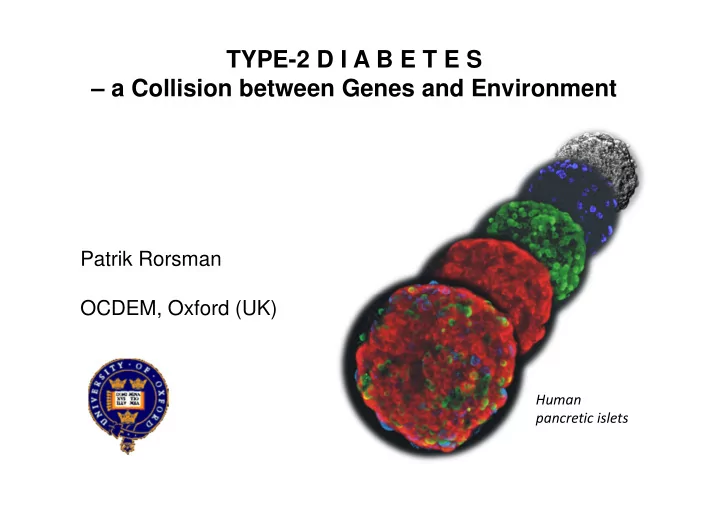

TYPE-2 D I A B E T E S – a Collision between Genes and Environment Patrik Rorsman OCDEM, Oxford (UK) Human pancretic islets
Glucagon Insulin Low blood glucose Glucose production (catabolism) Exercise Normoglycaemia Feeding Glucose storage (anabolism) High blood glucose Insulin Glucagon
Architecture of the human pancreatic islet Man: 1 million islets (1% of the pancreas volume/1 g of tissue) δ δ δ δ α α α α β β β β 50% β β β -cells, 40% α β α α α -cells, 10% δ δ δ δ -cells
“Rodent diabetes is not a major clinical problem”
Human islets • Transplantation to treat some type-1 diabetics (OXford Clinical Islet Isolation and Transplantation Centre) • Quality assessment • Opportunity to characterise human islet cells • >200 pancreases analyzed since 2006 • Genotypes known for some of the donors
T2DM associated with reduced GSIS Human islets 1 mM Isolated islets 20 mM
Glucose- dependent effects on β β β β -cell electrical activity in intact human islets
Consensus model of insulin secretion in human β β β -cells β Sulphonylureas (1950-)
Pancreatic islet function: Of mice and men ≠
Diabetes: a collision between genes and lifestyle?
Obesity and diabetes risk * Nurses’ Health Study, Carey et al., 1997 *Body weight/(height) 2
Diabetes incidence in Norway 1925-55: benefits of German occupation? Ashcroft & Rorsman 2012 Westlund 1966 (redrawn)
Long-term exposure to FFAs mimics effects of diabetes Reduced insulin granule fusion Human islets
Obesity, diabetes risk and insulin secretion Nurses’ Health Study, Carey et al., 1997 Hypothesis: Obesity � Chronic elevation of plasma FFA � Reduced GSIS � T2DM Chronic elevation of plasma FFA? Karpe et al., Diabetes, 2011 � Diabetes
Plasma FFAs become elevated during fasting K Frayn (redrawn) • FFA-induced suppression of GSIS is an Plasma NEFA after meal (<0.1 mM) evolutionarily preserved mechanism to protect against hypoglycaemia during starvation • This mechanism becomes erroneously activated in diabetes � GSIS ↓ • Pathology = Physiology?
Diabetes – ‘Starvation in the midst of plenty?’
“I see wonderful things” Lord Carnarvon and Howard Carter
Recommend
More recommend